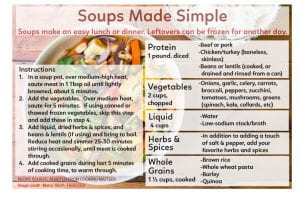You know the basics of saving at the grocery store: shop the sales, look for store brands, buy in bulk. But LOTS of food dollars still get wasted—just thrown in the trash—due to spoilage and waste. In the US, over 90 billion pounds of edible food gets tossed every year—that’s $370 per person! Let’s tackle that at the home level with some meal-savvy strategies…
You can’t do much about food losses during harvest or in stores. But you can save money at home with a little planning and by using leftovers wisely. Here are some ideas:
- CHECK what you have on hand BEFORE going to the grocery store (yeah, yeah, I forget too!).
- FIFO and LIFO: Not FIFO is First in, First Out, and this is how to put food away in cupboards and the fridge when you come home from shopping. LIFO is Last In, First Out (what most of us do), but it leads to spoilage of older food in the back.
- Weekly, go through the fridge and make a “STONE SOUP” or casserole with all the leftovers. Add extra onions, garlic, and tomato sauce, and serve over rice or pasta. Lots of hot sauce—tastes great.
- VEGGIES: save carrot ends, broccoli stems, the outer layer of onions—the parts you normally toss—in a zip-lock bag in the freezer. Every few weeks boil them up with some water and strain to make delicious stock for soups and stews.
- FRUIT: put bananas or other fruit that is getting overripe in smoothies or frozen fruit pops—great healthy snacks for kids!
- STORE food wisely. The warmest part of the fridge is the door. The coldest part is the bottom shelf in back (breaks the FIFO rule, but that’s where chicken should go to keep it fresh longest and avoid cross-contamination of other food). Here’s a handy infographic with lots more info:
- FOOD DATING INFO: It’s complicated (!), but you usually DON’T have to toss food that’s past date. Check out this post from North Carolina Extension on Best by, Sell by, and Use by dates:
- BUY LOCAL for the best value on the freshest produce. Subscribe to the Harvest Schuyler Hotline! http://cceschuyler.org/agriculture/harvest-schuyler
- Or GROW your own!
- COMPOST food scraps that are really too far gone or too woody to eat. If you don’t have a garden, make a deal with a neighbor who does: trade food waste now for tomatoes later. Look for Roger’s composting blogs coming up soon.
IF YOU NEED FOOD:
- Food Bank of the Southern Tier list of food pantry locations and schedules:
- Your school district is providing bagged meals for kids. Check the school web site for times and locations of drop-off points.
SOS Schuyler has some funds available for emergency needs of families: spiritofschuyler.org
RECIPE OF THE WEEK:
Brought to you by:
Joan Martin
SNAP-Ed Nutritionist, Southern Finger Lakes Region
jdm458@cornell.edu






